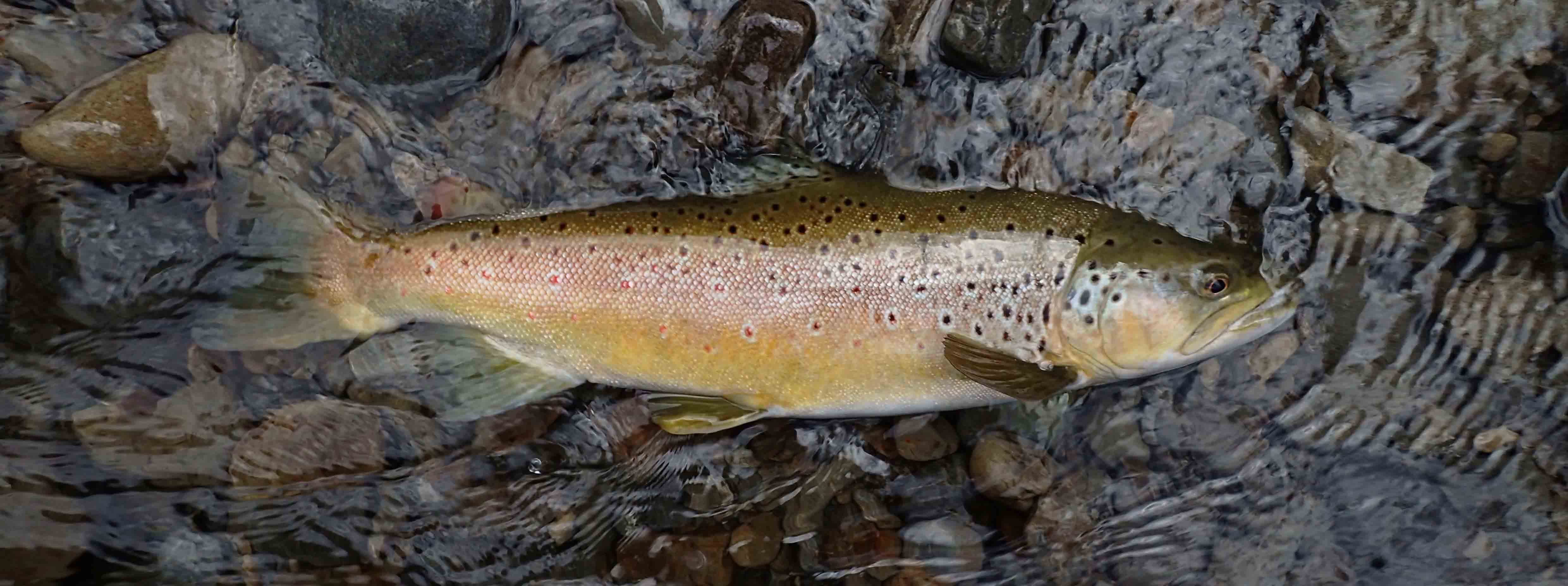Adult brown trout in New Zealand river systems are particularly flexible and individual in their responses to the environment, which make them very interesting to understand and fish for.
Brown trout can be broadly divided into four types: sea-dwelling, estuarine-resident, river-resident and lake-resident. Their selection of habitat gives rise to diverse and exciting fishing opportunities, e.g. casting streamers for sea trout in estuaries, fishing hatches or swinging streamers on lowland rivers, sight fishing on back country rivers and lake shores, and targeting spawning runs on large rivers.
Sea-dwelling trout
Sea trout spend much of their adult lives in the ocean. They enter the estuaries and lower reaches of many rivers in spring and early summer to feed, then again in late summer when they migrate upstream to their spawning reds (grounds).
Research on the chemical composition of trout otoliths (ear bones) and eggs shows that trout sub-populations return to spawn in the same tributaries every year, and that fish that are river-resident choose tributaries further upstream than those that live in the sea.
Sea-run brown trout are mostly fished for, using baitfish imitations, in spring and early summer in the lower reaches and estuaries of rivers. Even though the presence of sea trout in these environments coincides with the influx of whitebait, sea-run brown trout also feed voraciously on other species abundant at this time, like bullies, mullet, smelt and inanga (adult whitebait).
Bullies congregate in the lower reaches of rivers in spring to spawn, and smelt return en masse as adults to spawn in rivers in late spring and early summer.
Fishing for sea trout in estuaries is all about finding the fish.
As a general rule they are usually most abundant at the top of an estuary at high tide, then with the receding water the fish drop back into deeper channels closer to the mouth. Mouth areas generally fish well during low water and the first hour of the pushing tide, especially if this coincides with dawn or dusk.
When sea trout are not busting baitfish at the surface, it’s often necessary to fish flies close to the bottom, which usually requires a decent sink tip to penetrate a strong tidal flow. When trout are at the surface, a floating line or one with an intermediate head or tip are good choices. Flies that work well include woolly buggers, rabbit streamers and matuka patterns, such as the ‘grey ghost’ or ‘Hope’s silvery’.
Sea-run trout are also regularly taken, while fishing for resident fish, on nymphs and dry flies in the middle and upper reaches of river systems. The numbers of sea trout in the upper reaches of bush streams are usually highest in late summer and early autumn.
Sea-runs are easily identified by their silvery appearance, often with a purplish sheen, pointed tails and, because their scales are easily dislodged. Their colour changes from bright silver to gunmetal or polished bronze after being in freshwater for a few weeks.
Sea trout are spectacular fighters - sometimes cartwheeling over the water in a series of wild jumps, and frequently throwing flies too.
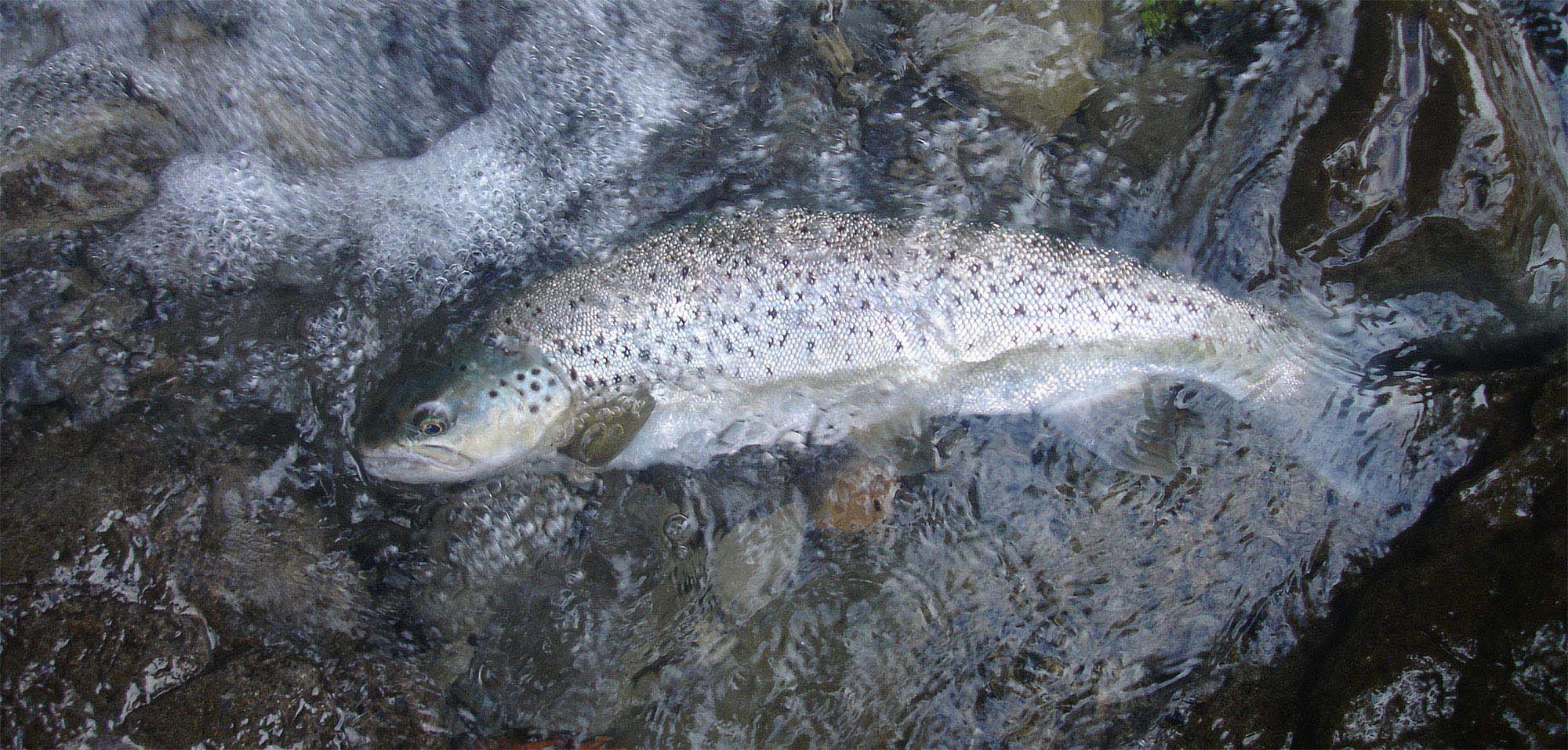
A bright sea trout taken from a bush stream in March

A sea-run brown trout after a few weeks in fresh water
Estuarine-resident brown trout
Some brown trout spend most of their lives in larger estuaries, only moving upstream to spawn. These estuarine resident brown trout are paler than the river-resident fish, but lack the bright silvery colouration of their sea-going cousins.
Estuarine-resident brown trout are frequently caught on baitfish imitations by anglers seeking sea trout in estuaries and the tidal sections of rivers.
It’s also likely that some river-resident fish spend time in estuaries in spring and early summer - when baitfish, including whitebait, smelt, bullies and mullet, are most abundant. Crabs, shrimps and snails are also frequently eaten by estuarine trout.
River-resident brown trout
Most river-resident brown trout are found in the lowland parts of river systems where food is most abundant, and the speed and strength of currents is more consistent and manageable for smaller fish. Larger fish, ranging between four and seven pounds, usually inhabit the more volatile backcountry upper reaches and headwaters.
Lowland Rivers
'Lowland' refers to the lower gradient section of a river found between the mountains and the estuary.
New Zealand lowland rivers typically flow through agricultural lands and have well-developed ‘reach-scale morphology’ – i.e. riffles, runs and pools - that are often bordered by willows.
Lowland fish usually make their homes in pools that provide protection and shelter, but feed in adjacent riffles where the nymphs of aquatic insects, e.g. mayflies and caddisflies, are more abundant.
Trout densities in lowland rivers tend to be sufficiently high (typically 200 to 300 fish per km) for blind fishing to be effective.
The usual approach is to prospect the riffles with a tandem nymph rig and, if a hatch develops, to target rising fish with emerger patterns, including soft hackles. Most of the dry fly action takes place in the pools, as emerging insects drift downstream on their way to the surface.
Mayfly hatches occur most often during the late afternoon or evening in summer, and in the early afternoon in spring and autumn.
During strong mayfly hatches trout may feed exclusively on emergers during the peak of the hatch, evidenced by their lack of interest in floating naturals, and the many bulging rises in which the fish’s snout does not break the surface. So, an emerger behind a dry fly is an effective tandem rig during mayfly hatches.
Intense caddis hatches occur on some lowland rivers in summer, usually beginning at dark and continuing for and hour or so. Swinging dry fly/pupae tandem rigs is exciting and effective.
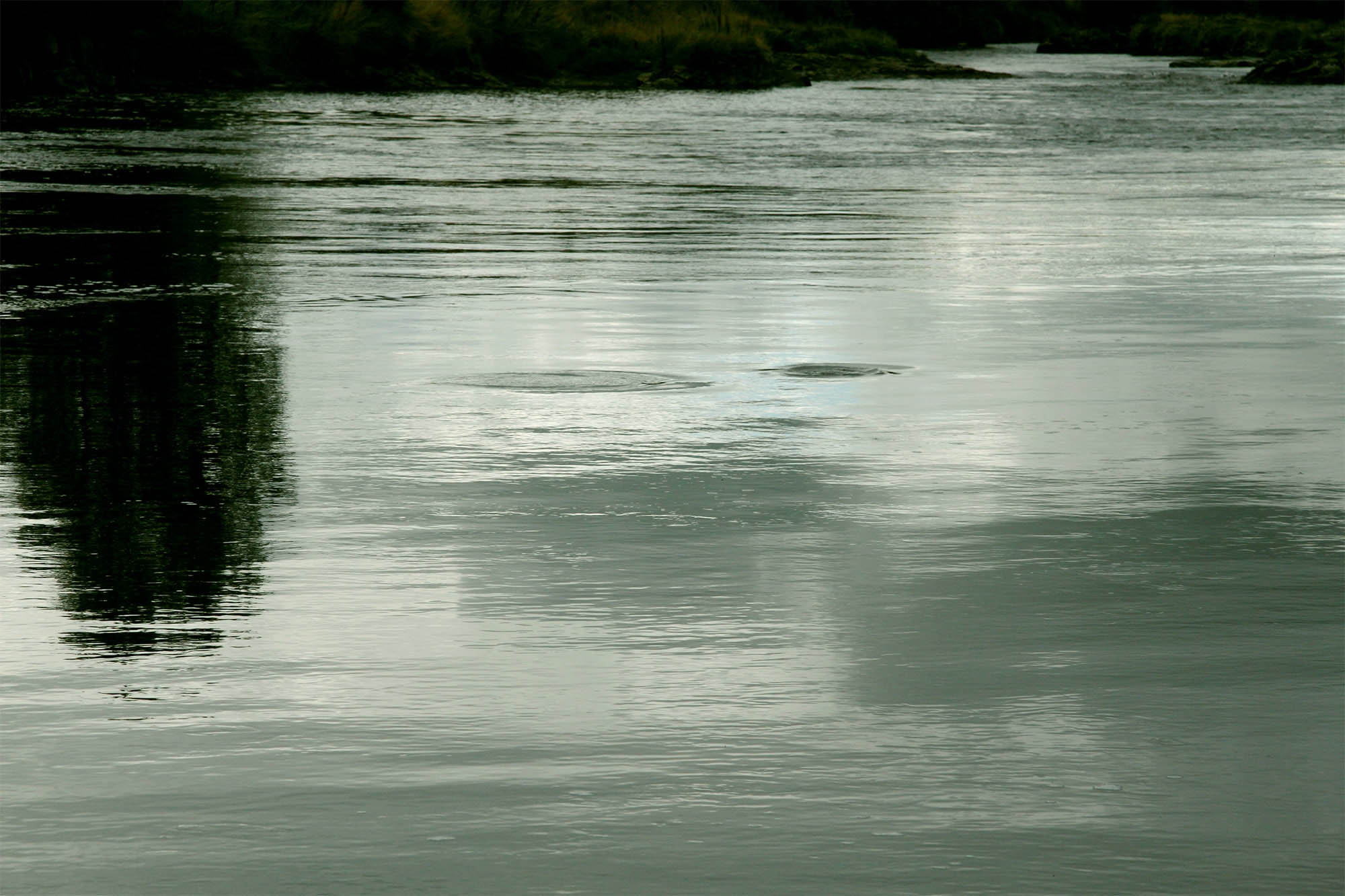
Mayfly hatch on the Mataura River - bulging rise forms reveal the fish are taking emergers
In late spring and summer, lowland streams also experience seasonal ‘hatches’ of terrestrial insects. Beetle, blowfly, hopper and willow grub imitations all work well when these naturals are about.
Dry fly/nymph tandem rigs, with the dry fly imitating an abundant terrestrial insect, are usually highly effective when terrestrials are about.
Apart from insect species, lowland rivers often have decent populations of forage fish that trout enjoy eating, including bullies, young trout, smelt and native galaxias. Baitfish imitations, such as woolly buggers and rabbit flies are therefore often taken aggressively, especially when the river has a hint of colour.
For those anglers hooked on Trout Spey, lowland rivers are venues of choice, providing options for fishing streamers, swinging soft hackles, with or without a mayfly hatch, and skating dry flies and pupae if a caddis hatch develops at dusk.
During daytime mayfly hatches, fishing with streamers usually draws more large fish than do soft hackles or nymphs.
Many lowland rivers have blind arms, known as backwaters, with little or no flow at normal river levels.
Backwaters, not to be confused with backcountry, are often inhabited by large trout cruising regular beats in search of food. Apart from good sight-fishing opportunities for these large trout, backwaters generally remain clear and fishable when the main river is flooding.
Dry flies, suspended blood worm imitations and small streamers all work well in these waters.
The trick is to establish the beat the fish is swimming, then when the fish is elsewhere, to cast into its predicted path and wait for its return - known as ‘setting a trap’. Dry flies and suspended nymphs should not move, but a nymph or streamer sitting on the bottom will need a twitch or two as the fish approaches.
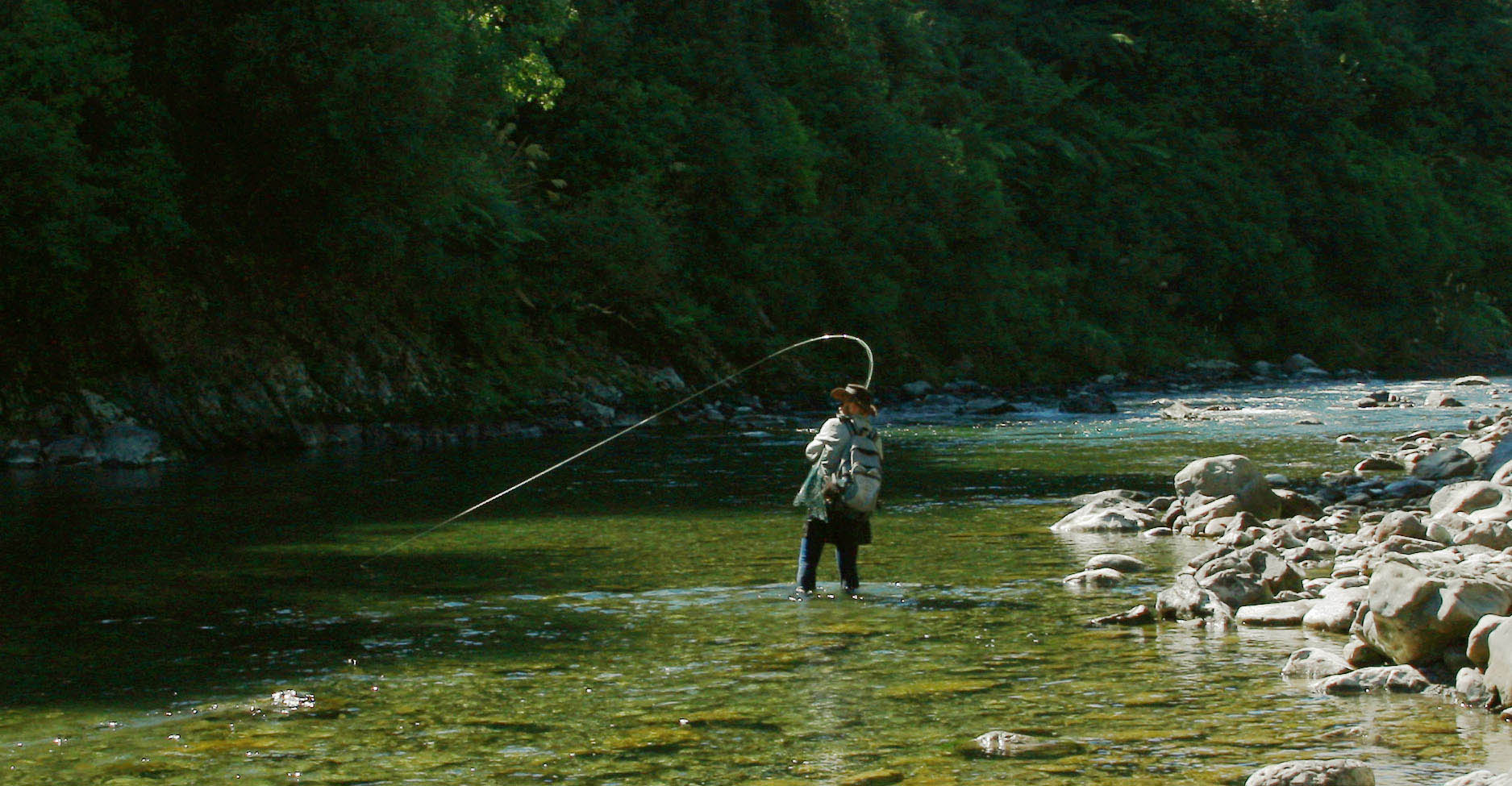
Hooked up on a typical bush stream
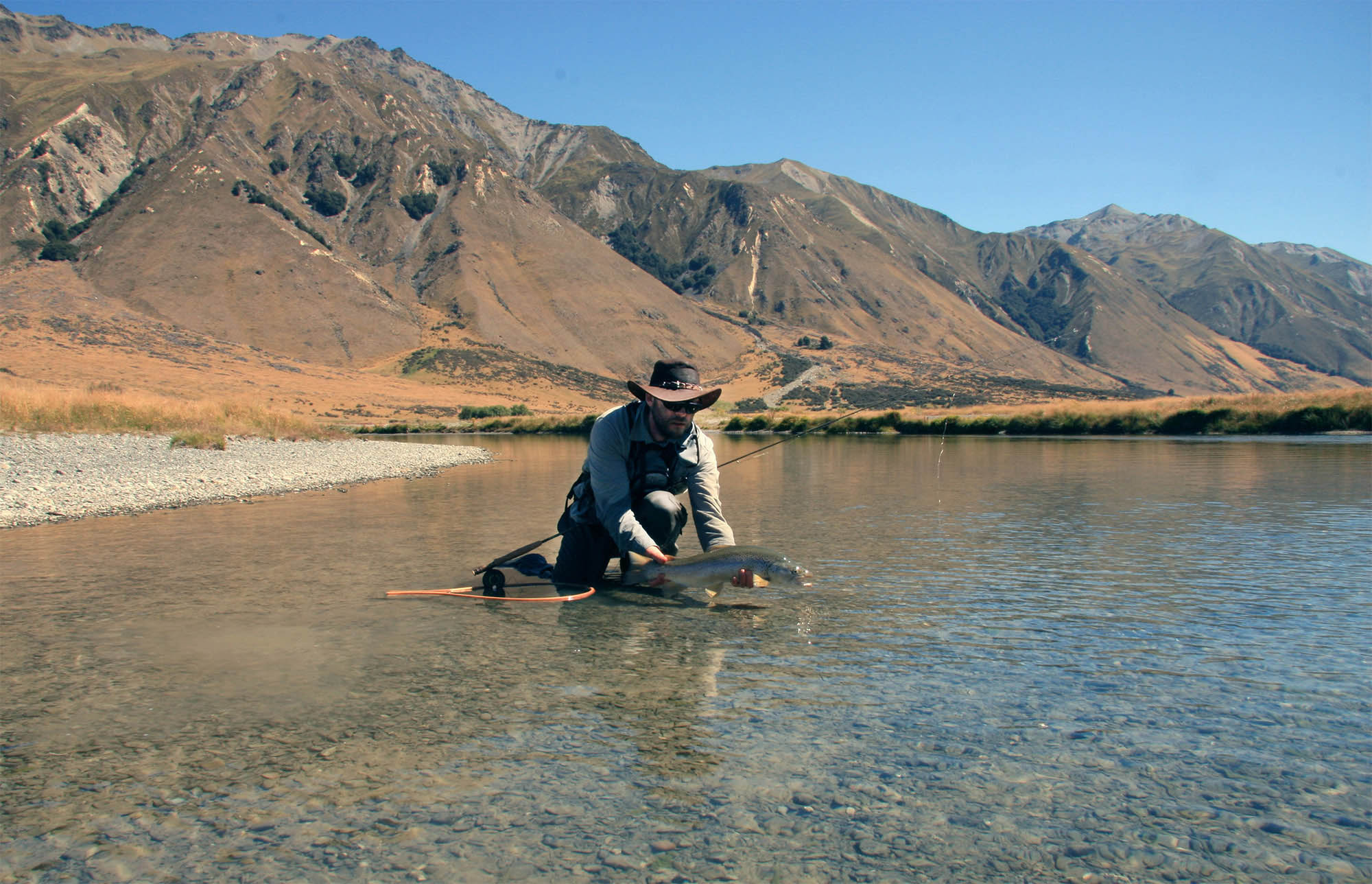
Success on an iconic high country river
Backcountry rivers
River-resident backcountry trout are able to grow to large sizes even though they feed predominantly on tiny insect larvae, as trout numbers are low (often <20 fish per km) and there is no competition for food. However, trout can only grow so big feeding on insects.
Double-figure trophy fish caught during late summer in the backcountry are mainly well-conditioned sea-run trout returning to their spawning tributaries, after spending most of that year stuffing themselves on protein-rich marine fish like mullet, sprats and smelt.
Some backcountry brown trout, especially those found in the headwaters of beech forest rivers, can reach trophy proportions by feeding on mice.
Masting and Mice
Every three to five years, New Zealand’s three species of beech tree produce bumper seed crops, known as 'masting'. Mouse populations in these forests explode in response to this increase in seeds, as well as insects such as caterpillars feeding on the beech flower litter.
Mice are not afraid of water and during ‘masting’ population explosions, many attempt to cross rivers and lakes at night, when they are most active. Local trout soon learn to seize these high calorie packages of food, and these trout can gain condition incredibly fast.
Most resident backcountry brown trout are male fish in average condition. But during a ‘mouse year’, in just a few months, a 7 lb fish in average to poor condition can become a 9 to 10 lb fish in excellent condition. Autopsies on mouse feeding trout have revealed more than 20 mice in a stomach.
Fat mouse-eating trout are mostly caught during the day using nymphs, when they sit on the bottom digesting the previous night’s feast. Although swinging ‘mouse imitations’ at night across pools or river mouths flowing into lakes can produce outstanding action.
The standard approach to fishing sparsely populated backcountry and headwater streams, is to cast only to sighted fish - see my article, below,'Fly fishing the backcountry' for more on fishing these special places.
Lake-resident Brown Trout
The lifestyles of lake-resident brown trout depend largely on the type of lake in which they live.
Deep Lakes
New Zealand’s deep and clear lakes have substantial offshore zooplankton populations living in the ‘pelagic zone’, i.e between the bed of the lake and the water’s surface. Zooplankton feed on microscopic diatoms, and are in turn fed on by the larvae of landlocked Koaro (Galaxias brevipinnis) and common bullies, and in the North Island, adult populations of introduced smelt (Retropinna retropinna).
Young brown trout either remain in the tributary in which they were spawned, or they begin a ‘pelagic lifestyle’ after entering the deep lakes and feeding on smelt and the larvae of bullies and koaro.
Once they’ve grown to two to three pounds, they move to the lake margins where they feed on adult bullies, snails, freshwater crayfish, and the nymphs of aquatic insects, such as damsel and dragonflies.
During summer, many deep lakes provide good sight fishing along their margins for large brown trout. Nymphs, dry flies and small streamers are all effective for sighted fish, and angling techniques are similar to those described for backwaters (above).
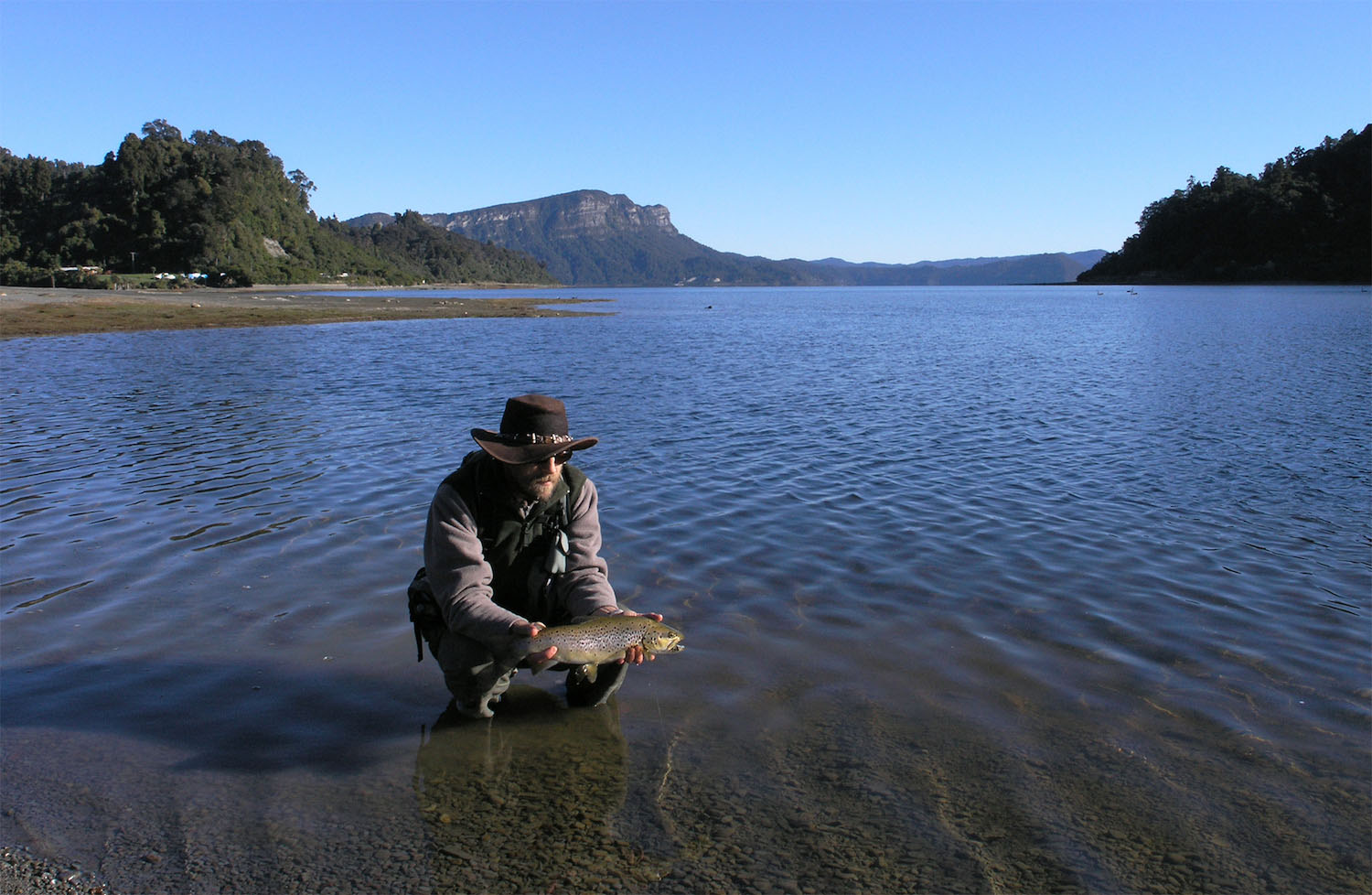
Sight fishing the margins of Lake Waikeramoana
Large rivers that flow into large lakes, like the Tongariro flows into Lake Taupo, have good runs of large brown trout in autumn, when adult fish make their way upstream to spawning tributaries.
While these trout are regularly caught when nymphing, they are best targeted with streamers, down deep during the day and near the surface at night. Large Woolly Buggers and rabbit streamers are effective, and black is always reliable at night and in discoloured water.
Migrating fish usually gather at stream mouths then enter the river during the next fresh. These fish may also be caught by fishing at the stream mouths at night either using a dark buoyant fly, such as a booby, on a high-density line, or a large dark lightly-weighted streamer on a slow sinking line.
In both cases, it’s advisable to use two flies: a large black streamer trailed by a smaller luminous one (lumo) charged by a head torch. Lumo flies are mostly taken by rainbows, as after dark they are unable to see as well as brown trout.
In autumn, large deep lakes without smelt populations, notably those on the South Island, have whitebait runs at stream mouths, which coincide with the pre-spawning movement of adult brown trout in good condition. From March to May, fishing the stream mouths with whitebait imitations can be a lot of fun.
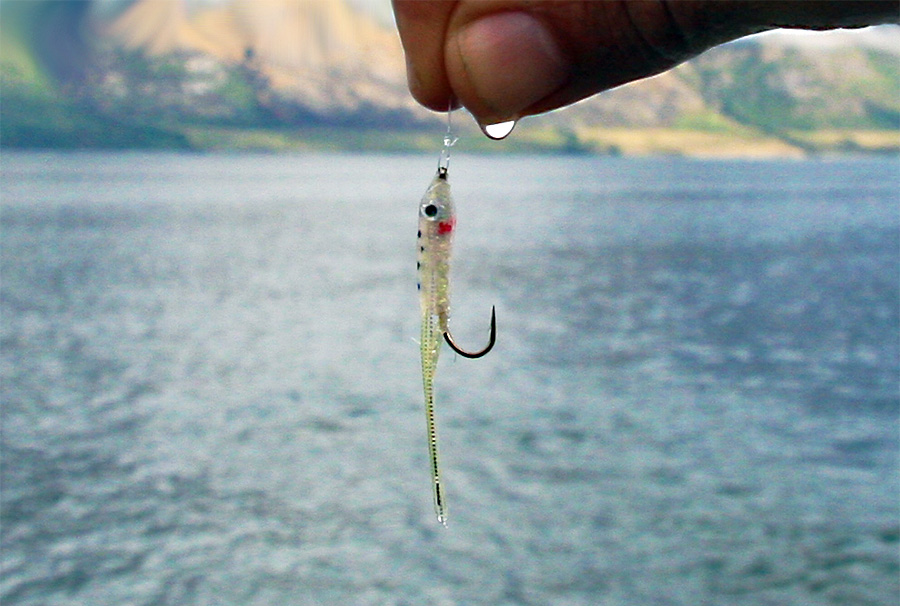
A good imitation is essential as the water is invariably crystal clear. Effective imitations range from ultra-realistic whitebait designs moulded out of silicone, to a very sparse wing of white bucktail and one or two strands of flash.
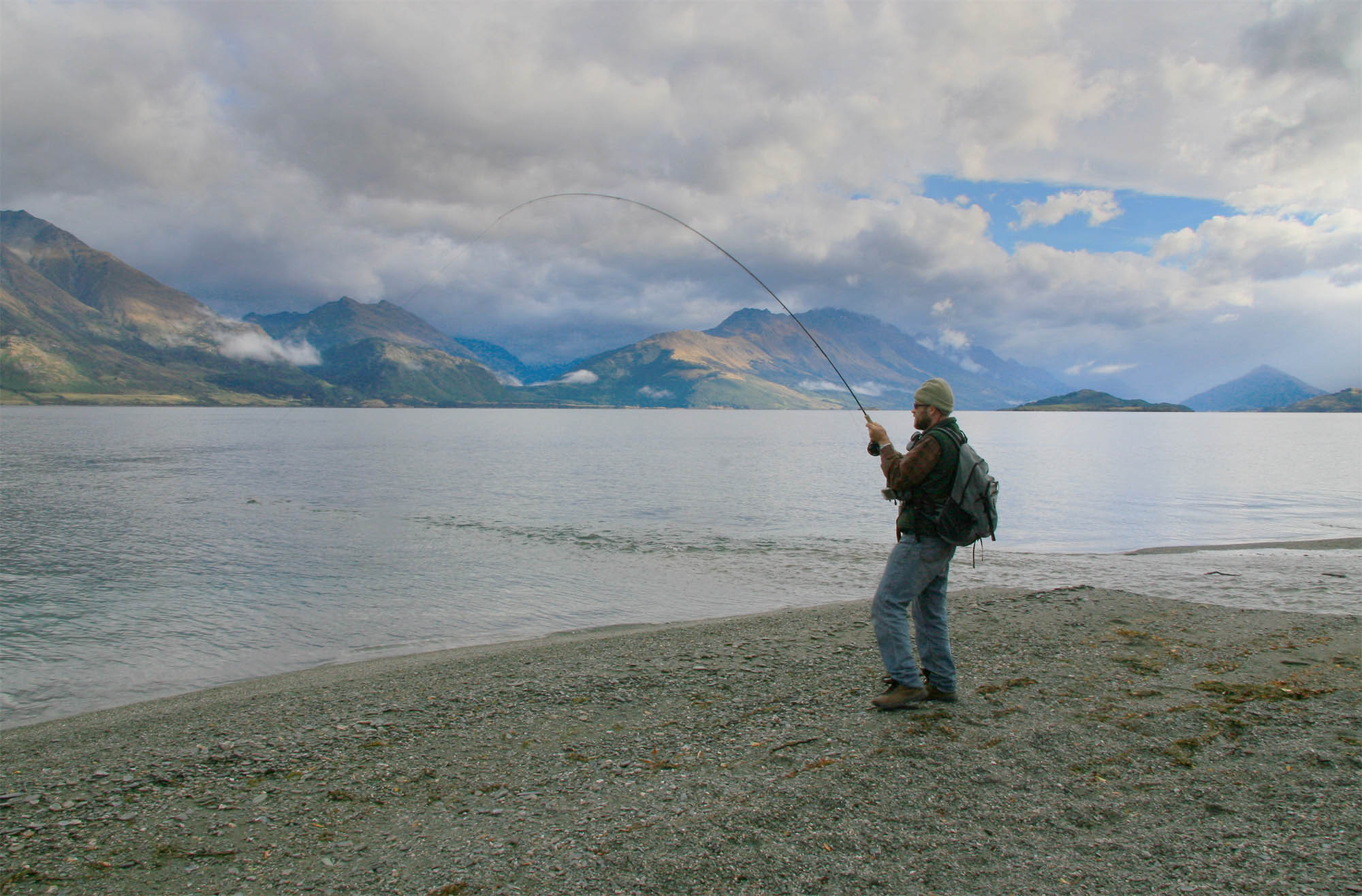
Using a whitebait imitation at a stream mouth on crystal clear Lake Wakatipu
Shallow Lakes
In shallow lakes, brown trout of all sizes feed in weed beds that support their main sources of food, including: snails, crayfish, bullies and damselfly and dragonfly nymphs. Prospecting weed beds with nymphs and streamers using floating or intermediate lines is generally most effective, although sight fishing is also possible.
Dry flies come into their own when terrestrial insects such as green beetles and cicadas make their appearance in summer.
In my next article I write about the life styles of rainbow trout, and the unique fisheries they have given rise to.
